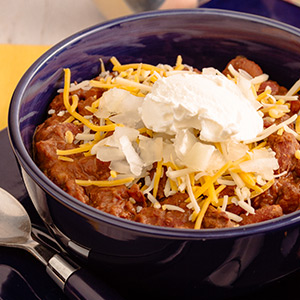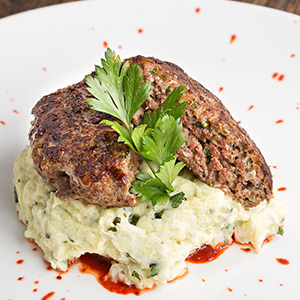Wapiti
All About Wapiti

When the colonists first came to Canada, the elk, or wapiti, roamed the country from coast to coast. Today, the only place they run wild is in the western provinces.
Their meat is very lean, rich in vitamins and high in protein. Like the red deer, elk are also raised for their velvety antlers, which are processed and used in various medicinal powders.
Elk does not require salt or pepper to enhance its flavour, but it does pair well with a range of spices and seasonal ingredients.
Cooking methods for elk

Roasted elk
With this method, tender cuts of elk are cooked in a medium-hot (200°C (390°F) oven in an open casserole without any added liquid. Less tender cuts, like eye of round or cross-rib, should be roasted, in liquid, in a covered casserole.
1In a shallow roasting pan, heat a little clarified butter or oil and sear tender cuts of wapiti on all sides.
2Transfer the roasting pan into a pre-heated oven and cook to the desired degree of doneness. Midway through cooking, insert meat thermometer in the fleshiest part of the roast.
3For less tender cuts, sear meat on medium-high for three or four minutes, remove from pan and let stand.
4Deglaze roasting pan with broth, approximately 250 ml (1 cup), on medium heat. Let boil for one minute.
5Return meat to roasting pan, cover and cook in the oven until desired degree of doneness; mid-way through cooking, insert meat thermometer in the fleshiest part of the roast.
Grilled elk
With this method, steaks are seared on medium heat.
- On the stovetop, in the oven or on the barbecue, quickly sear meat on high heat, then reduce heat to medium.
- Cook for 6 to 10 minutes, depending on the thickness of the steaks, turning only once using tongs to avoid piercing the meat and losing any juice.
Sautéed elk
With this method, steaks are seared on medium heat.
- Season elk strips with spices.
- Heat a little oil in a frying pan or wok and sauté meat over medium heat for 2 to 3 minutes.
Braised elk
With this method, elk meat is cooked slowly at low heat in a covered casserole with liquid and vegetables.
- Preheat oven to 140°C (275°F).
- Coat the meat with a mixture of flour and dry mustard.
- Brown meat in a little canola oil.
- Add broth to cover the meat halfway.
- Add aromatic vegetables, onions, leeks, carrots and a bouquet garni. Cover and cook in the oven for approximately 2 hours.

Stewed elk and elk in sauce
Slow-cook elk meat in a covered casserole with a large quantity of liquid and aromatic vegetables.
1Coat cubes of wapiti with seasoned flour.
2Brown cubes in a little oil.
3Add aromatic vegetables and mix well.
4Add enough liquid to cover the meat.
5Cover and simmer over medium heat.
Tips and advice

- Elk meat is naturally lean and dense, so it loses very little volume in cooking.
- The flavour of elk is rich, robust, slightly sweet, and lighter than that of wild game.
- Even though they have different flavours and textures, red deer and elk are interchangeable in all recipes.
- Like red deer, elk is usually available in the same cuts as beef, from tenderloin and steak to stewing cubes, lean ground meat and more.
- Elk steaks, medallions and tournedos are usually cut from the thigh in 150-gram portions.
- On high heat, elk cooks quickly to rare or medium rare (pink).
Expert Tip
Roasted leg of elk is ideal for four or more people. Calculate approximately 200 grams (7 ounces) per portion.
How to know when cooked elk is done
When cooking elk, check for these internal temperatures to make sure your meat has reached the desired degree of doneness. For the best juicy and tender results, elk should be cooked to rare or medium pink.
For: Rare meat
Cook to: 60˚C (140˚F)
For: Medium pink meat
Cook to: 63˚C (145˚F)
For: Well-done meat
Cook to: 70˚C (160˚F)
Nutritional value

Elk meat is five times leaner than beef. Low in calories and cholesterol, it is a good source of protein. Elk is also rich in iron and vitamin B.
Storage
Fresh elk will keep for one or two days in the refrigerator. Different cuts can be individually wrapped and stored in the freezer for three to six months.
Always defrost your meat in the refrigerator, allowing four to six hours per kilo.















